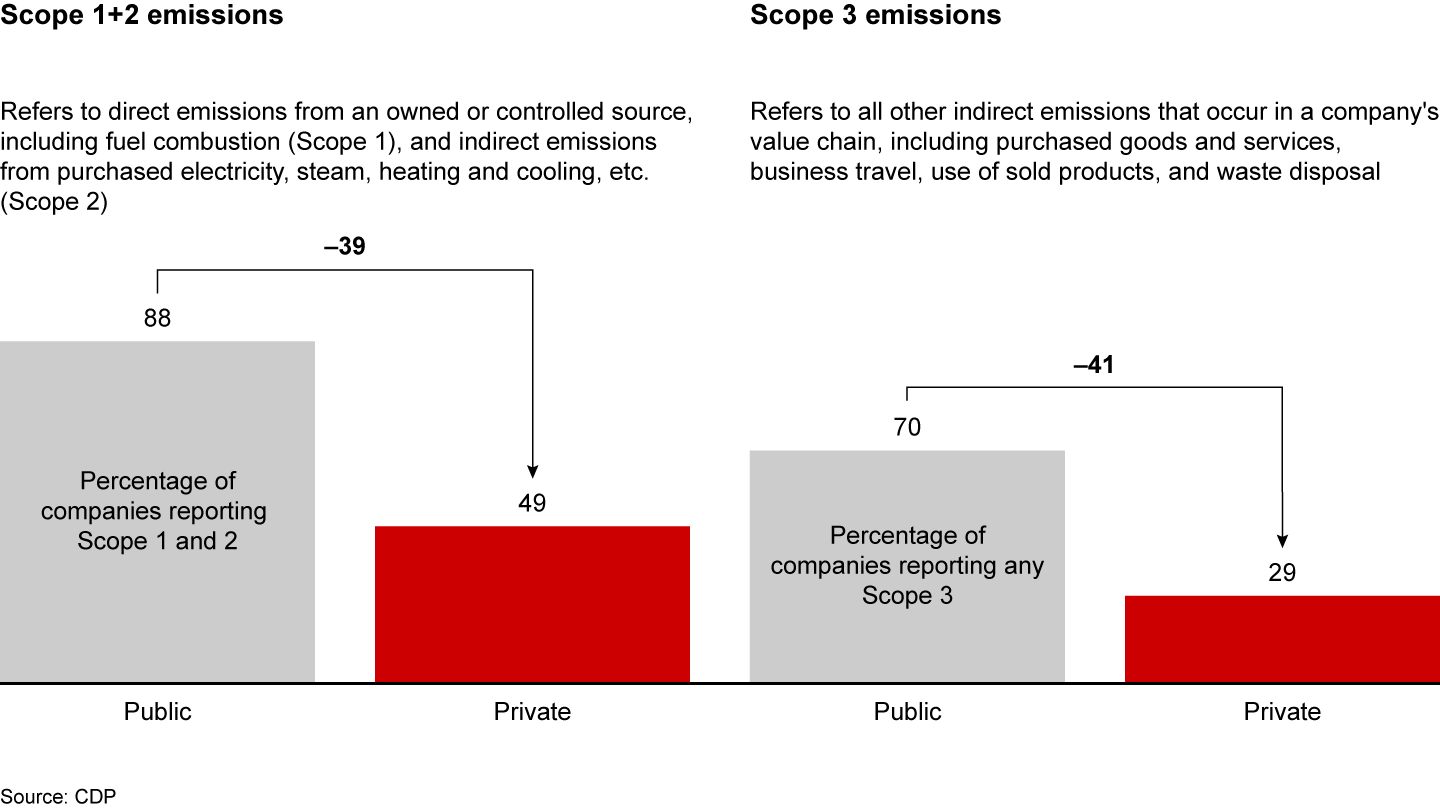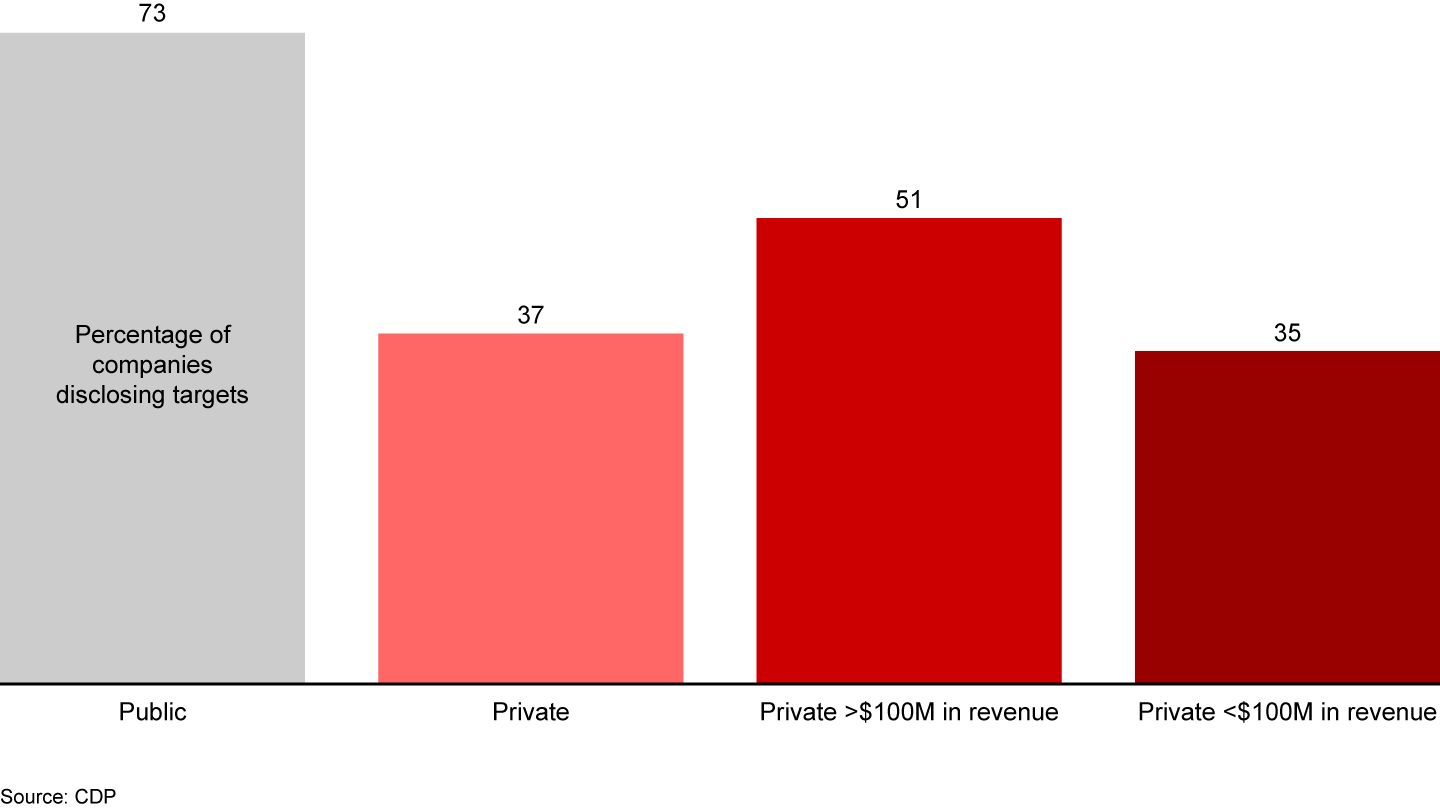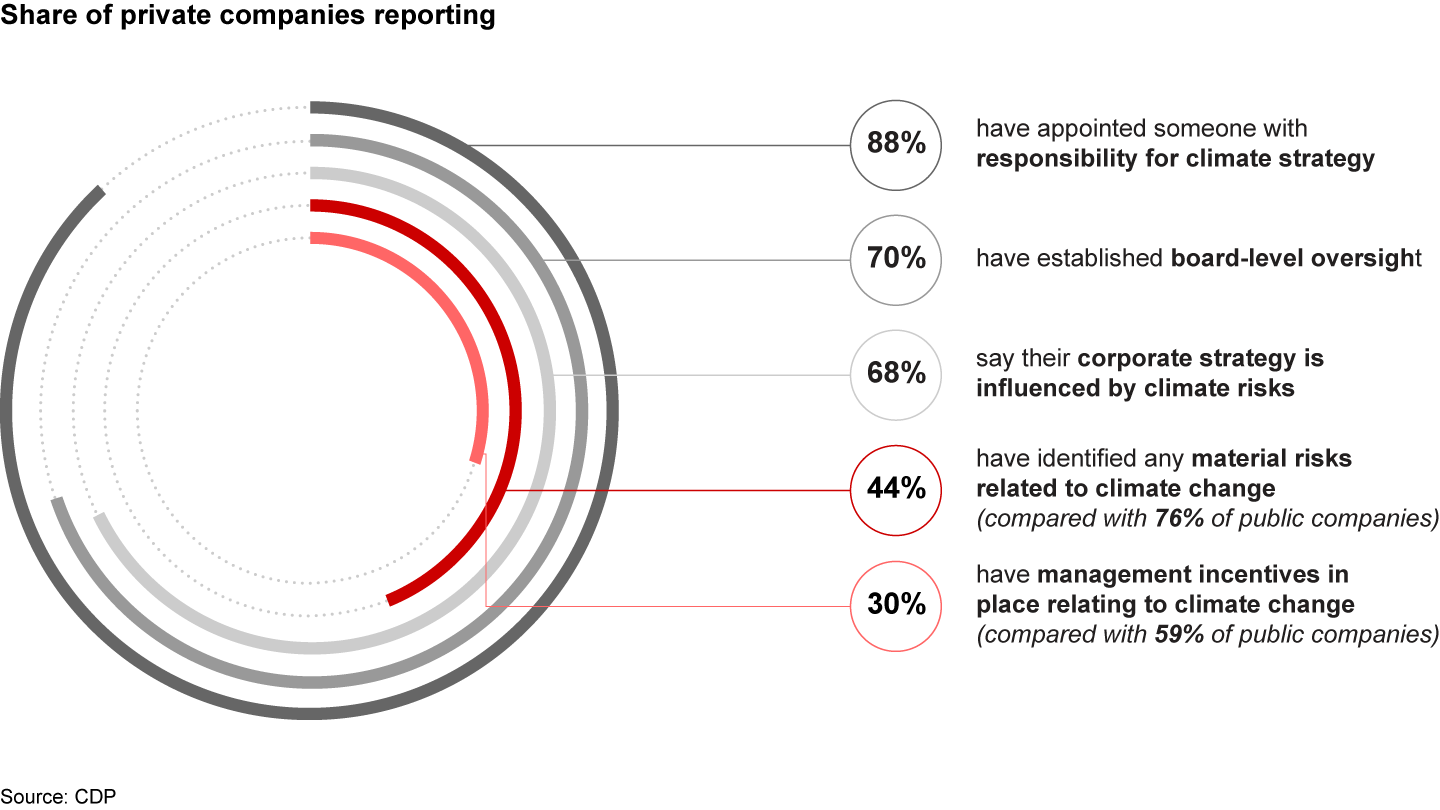Brief

At a Glance
- Despite growing pressure from investors, customers, and regulators, private companies trail public companies by a wide margin in reporting on environmental impacts.
- Private companies tracked by CDP cite resource constraints, capability gaps, and a lack of urgency from leadership as challenges to better reporting.
- Yet as demands for transparency build, the most proactive firms aren’t standing still. They are developing clear, pragmatic strategies to measure and mitigate impacts one step at a time.
It’s no secret that private companies trail their public counterparts when it comes to tracking and reporting on environmental impacts. But recent data collected by CDP, a nonprofit group that runs the world’s largest environmental disclosure system, helps quantify how wide the public-private gap really is.
Written in collaboration with
Written in collaboration with

More than 13,000 companies, a third of which are public entities, report to CDP on environmental and climate impacts. Yet while the 4,400 public companies in CDP’s database cover 64% of global public market capitalization, the 8,700 private companies that report represent a tiny fraction of private market capitalization globally (see Figure 1).

Data from CDP’s Climate Change 2021 Questionnaire, analyzed in conjunction with Bain & Company, shows that those private companies are far less likely than their public counterparts to report on greenhouse gas emissions. Only 49% of them report on Scope 1 and 2 emissions, compared with 88% of public companies. And just 29% report on any Scope 3 emissions vs. 70% of the public cohort (see Figure 2). The effective coverage of Scope 3 emissions reporting is probably much lower, as many public and private companies are not yet reporting comprehensively on all 15 categories of Scope 3 emissions.

The gap also extends to ambition. While 73% of public companies actively set emissions reduction targets, just 37% of the private enterprises do. Larger private companies (those with more than $100 million in revenue) perform somewhat better than smaller companies in this planning function. But still only 51% of them reported setting any targets (see Figure 3).

Private companies aren’t ignoring the climate issue. Many have taken important steps toward institutionalizing oversight of their climate-related performance. A full 88% say they have appointed someone with responsibility for climate strategy, and 70% have established board-level oversight.
But many still have work to do when it comes to translating oversight into meaningful action (see Figure 4). Close to 70% of private companies say their strategy is influenced by climate-related issues, but only 44% have identified material risks related to their environmental impact (compared with 76% for public companies). And though 59% of public companies reporting to CDP have put management incentives in place aimed at improving environmental impact, only 30% of private companies have done so. Based on current plans for implementing incentives, 81% of public companies will have such plans in place in two years’ time vs. 66% of private companies.

For those working toward a future of net-zero emissions, these findings help quantify the scope of the challenge ahead. They highlight how difficult it will be for the corporate world to mitigate climate-related impacts without broad participation across both sectors of the global economy.
In an oft-quoted speech at the COP26 conference in Glasgow, BlackRock Chairman Larry Fink gave voice to another issue compounding this challenge when he suggested that companies hoping to avoid the costs associated with climate reporting and action will intentionally take fossil fuel-related assets private to escape public scrutiny. Consider that fewer than 10% of the public companies reporting to CDP in 2016 had gone private by 2021. But once they were in private hands, 85% of them had stopped reporting to CDP.
While some owners will be tempted by what Fink colorfully called “the biggest capital market arbitrage in our lifetime,” the reporting gap between public and private companies also stems from a mix of resource constraints, capability gaps, and a lack of urgency from leadership. As noted above, smaller companies are skewing the private sector numbers downward as these enterprises are the least likely to have the wherewithal to make investments in tracking and reporting. They cite more pressing business concerns, lack of resources, and scant top-level sponsorship as reasons for not having begun measuring to date. A lack of a standardized reporting mechanisms hasn’t helped.
But the market pressures being brought to bear on public companies—pressure from customers, investors, and regulators to increase transparency and boost performance—are rapidly extending across the reporting gap. As a recent survey conducted by Bain and the Institutional Limited Partners Association (ILPA) shows, 70% of the institutions that private markets rely on most for capital have adopted environmental, social, and governance (ESG) policies, and 85% of those have carried out or are implementing policies aimed specifically at private equity investments. A full 93% said they would walk away from an investment if it posed an ESG concern, and 80% expect to ramp up requests for ESG reporting from general partners (GPs) over the next three years.
What these numbers suggest is that even the small- and medium-sized companies populating private equity portfolios are increasingly coming under scrutiny from investors. Regulators, too, are turning up the heat. Mandatory carbon reporting is already being rolled out in the European Union (EU), and regulators in North America are also mulling new rules to boost reporting requirements.
At the same time, consumers and employees are loudly expressing their concerns when it comes to climate change. Consumers are increasingly shifting purchases to companies that offer environmentally friendly products and can demonstrate adherence to ESG policies. Top talent is likewise gravitating to companies that take sustainability and fairness seriously. Strong performance, in other words, is increasingly tied up in providing evidence of ESG-related performance through consistent and reliable tracking and reporting.
Those forces—especially regulation—are likely to be the most powerful factors in closing the reporting gap between public and private companies. But it will also be critical for reporting itself to mature. The Bain-ILPA study shows that a lack of specific data standards and best practices related to ESG is clearly hampering PE investors’ ability to consistently evaluate ESG performance across their portfolios. CDP finds that private companies are generally enthusiastic about seeking solutions and are responsive to reporting requests, especially from investors. Finding easier ways to comply appears to be the bigger conundrum.
Yet leading private companies are making strong progress, anyway. They are focusing on what they can do now, despite the hurdles, and taking practical steps to get the ball rolling. The firms looking to get a better handle on how and where to reduce greenhouse gas emissions, for instance, are:
- Developing a carbon baseline to establish a starting point and identify where the company’s biggest sources of greenhouse gas emissions come from.
- Establishing a focused plan by laying out both a long-term ambition and a short-term, high-impact set of initiatives to establish momentum and build credibility.
- Communicating the ambition. As with any critical shift in how a company operates, communication and buy-in starts at the top and cascades down through the organization. It’s up to leadership to model a serious commitment to pushing toward net-zero.
- Tracking progress against it. In the spirit of you can’t manage what you can’t measure, reporting and transparency are essential. Establishing a dashboard and metrics to track progress will accelerate change and give the company a means to trumpet success.
Establishing a practical, credible roadmap for reducing emissions and mitigating other environmental impacts can be a difficult undertaking, especially for a company with complex industrial assets or a global supply chain. But as the need grows, an ecosystem of support is expanding rapidly. Third-party services are emerging to help companies identify and measure output in real time. Others allow investors (as well as suppliers, customers, and other stakeholders) to request sustainability ratings for individual companies and their supply chains, as well as clarify material sustainability themes.
CDP is one such organization that is collaborating with both LPs and GPs to expand the scope of its disclosure infrastructure. That will facilitate disclosures from portfolio companies, establish transparency, and manage environmental performance. Working with investors with over $2.3 trillion in assets under management, CDP has created the first-ever standardized climate change disclosure platform specifically aimed at private markets. It includes a mechanism for modeling emissions based on reported input data.
There will always be market players who try to escape scrutiny around their environmental footprint. But many private companies are simply searching for the best, most economical ways to measure their environmental impacts and mitigate them. New tools and methodologies are emerging every day. Investors, customers, employees, and regulators are all letting private companies know that now is the time to start putting those tools to work.
The authors would like to thank Michael Galeski of CDP for his contributions to this brief.




